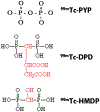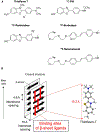State-of-the-art radionuclide imaging in cardiac transthyretin amyloidosis
- PMID: 30569412
- PMCID: PMC6541031
- DOI: 10.1007/s12350-018-01552-4
State-of-the-art radionuclide imaging in cardiac transthyretin amyloidosis
Abstract
Cardiac amyloidosis, once considered untreatable, is now gaining well-deserved attention due to advances in imaging and the recent approval of targeted breakthrough therapies. In this paper, we discuss the role of radionuclide imaging in the evaluation and management of patients with the most common form of amyloidosis-cardiac transthyretin amyloidosis (ATTR). We provide a comprehensive summary of the literature interspersed with our institutional experience as appropriate, to deliver our perspective.
Keywords: Amyloid heart disease; PET; SPECT; modalities; molecular imaging.
Figures











References
-
- Adams D, Gonzalez-Duarte A, O’Riordan WD, Yang CC, Ueda M, Adams AV, et al. Patisiran, an RNAi Therapeutic, for Hereditary Transthyretin Amyloidosis. N Engl J Med 2018;379:11–21. - PubMed
-
- Benson MD, Waddington-Cruz M, Berk JL, Polydefkis M, Dyck PJ, Wang AK, et al. Inotersen Treatment for Patients with Hereditary Transthyretin Amyloidosis. N Engl J Med 2018;379:22–31. - PubMed
-
- Falk RH. Diagnosis and management of the cardiac amyloidoses. Circulation 2005;112:2047–60. - PubMed
-
- Kyle RA, Gertz MA. Primary systemic amyloidosis: clinical and laboratory features in 474 cases. Semin Hematol 1995;32:45–59. - PubMed
Publication types
MeSH terms
Substances
Supplementary concepts
Grants and funding
LinkOut - more resources
Full Text Sources
Medical
Research Materials

